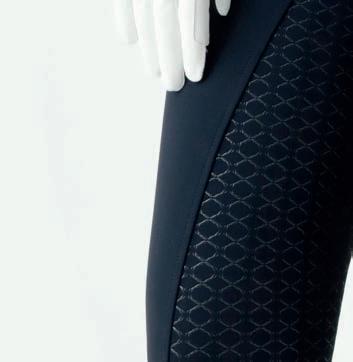
15 minute read
Joint care
SOUND DECISIONS
DRESSAGE PLACES A SIGNIFICANT DEMAND ON HORSES’ JOINTS, SO THE MANAGEMENT OF THEIR HEALTH THROUGH GOOD NUTRITION, CORRECT TRAINING AND CONTINUED MONITORING IS VITAL TO A LONG CAREER, REPORTS BARBARA YOUNG.
When it comes to management, staying sound or the demands o dressage re uires a delicate balance.
According to Andy athe, artner at ewmar et s ossdales uine os ital, riders need to ta e the whole horse into consideration and wor closely with their su ort team to hel minimise ris . It s the whole inter lay between the vet, trainer, arrier, hysio etc who together ma e a ac age, as well as owners not being overly demanding and allowing the horse to have an off day, rather than utting ressure on the rider to always er orm,” he e lains. oints aren t there in isolation i the sus ensories get in ured which is common , this will ut more strain on the hoc and oints. he most common in ury in dressage horses is the high sus ensory. As the horse goes u the grades, there is more demand on collection and wor ing rom behind which increases loading on hoc s and sus ensories.”
Andy also cautions against too much re etition o advanced movements. tatistically, it s grand ri horses which have the highest ris o in ury, although to riders don t ractice movements such as iaffe assage very o ten as horses at this level already have the s illset. owever, or less e erienced riders who are struggling with a s ecific movement, it s better to ta e a brea and move on to doing something different rather than ee re eating. eal with any issues early on i you sus ect something isn t uite right, don t ut your head in the sand.”

STATISTICALLY, IT’S GRAND PRIX HORSES WHICH HAVE THE HIGHEST RISK OF INJURY
SUPPLEMENTARY HELP According to experts, advancing age and exercise over prolonged periods can lead to a breakdown in the natural regeneration process, resulting in joint discomfort and stiff ness.
Ryan Millar and Tim Mansi, directors of BETTALife, manufacturers of PharmaQuin Joint Complete HA, point out that while many joint supplements can help rebalance this process, it’s important to look at each component to fully understand which are necessary. hey say only a ew glucosamine, chondroitin, and A have been shown to be use ul in maintaining healthy oints.
“The equine joint is made up of articular cartilage, synovial uid and so t tissue structures that hold the joint together (capsule and ligaments .
“Depending on the horse’s requirements, supplements can be fed at a maintenance level to support ongoing joint health, as well as added strategically when equines are injured or suff ering rom oint ain.”
They point out that where a horse has shown a change in gait or reluctance to move orwards, it may benefi cial to eed a supplement to help boost natural joint re airing substances.
“The best approach is to read the labels to make sure the product contains appropriate ingredients in eff ective amounts and always loo or the Clean ort logo.”
Andy Bathe agrees that supplements have a lace in routine maintenance.
“Once the horse is working at a higher level lementary edium and above I would advise a broad-spectrum joint supplement as there isn’t compelling evidence that one particular substance is more easily absorbed than another.”
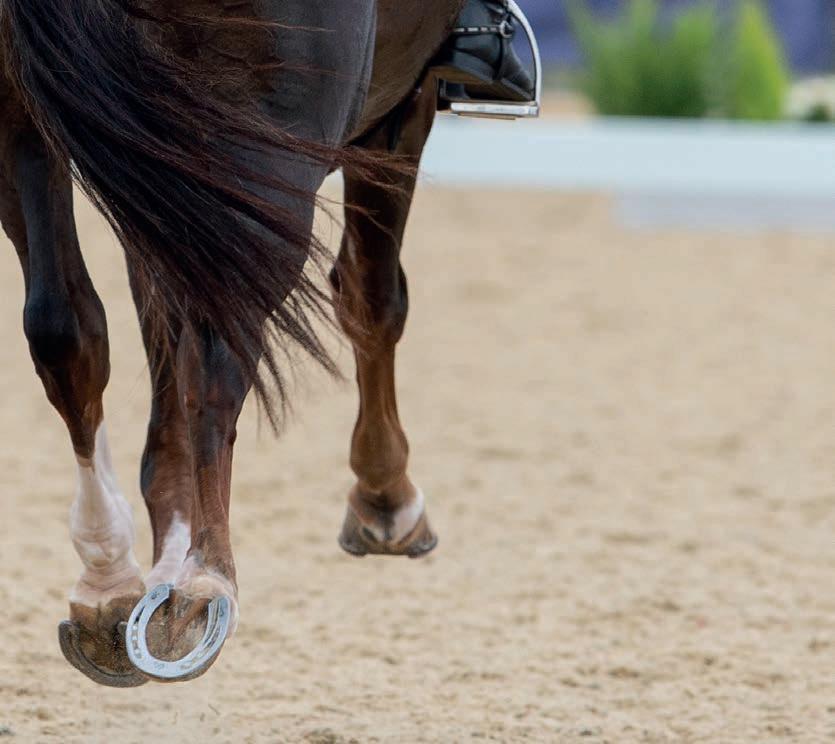
OPPOSITE: ACCURATE DIAGNOSIS IS VITAL BEFORE CONSIDERING ANY TREATMENTS FOR JOINT PAIN. ABOVE: MANAGEMENT OF JOINT HEALTH CAN HELP THE HORSE HAVE A LONG AND TROUBLEFREE CAREER. RIGHT: AS THE HORSE GOES UP THE GRADES THERE IS MORE DEMAND FOR COLLECTION AND WORKING FROM BEHIND WHICH INCREASES LOADING ON THE HOCKS AND SUSPENSORIES.

UNDERSTANDING TREATMENTS
MRI: “Accurate diagnosis is vital,” explains Andy Bathe. “It doesn’t matter what the problem is, if you stick a needle in the wrong joint, it’s not going to help.” Steroids: “Using steroids in a diseased joint helps to break the infl ammatory cycle, although there are risks of laminitis. We often see young horses who may have sore hocks when they’re six; we treat them once and they don’t have a problem again for a long time.” Biologics (PRP, IRAP, Prostride): “These are all similar – biological soups with growth factors and anti-infl ammatory to help promote the healing response. Stem cell: “There is a licenced product which owners are reporting a good response; it will be interesting to see how this pans out long term; can be expensive.”
Polyacrylamide hydrogel (Arthramid):
“A ‘fi ller drug’ developed for the cosmetic industry and injected into joints. Can be a real turnaround drug in some nonresponsive joints. Not licenced in the UK, but imported fairly easily through vets.”
Arthroscopy (keyhole
surgery): “Owners having routine steroid injections might want to consider having a look inside to see if there’s a torn meniscus, ligament or fragments as this may be more effective.”


SURFACE SOLUTIONS Studies have shown that training on a suitable sur ace is also benefi cial.
According to David Andrews from Andrews Bowen, research has shown that a dressage horse puts more force per square inch on a surface than any other equestrian discipline, especially when wor ing laterally.
“When a dressage horse is doing 80% of its training in an arena, the composition o a sur ace is critical. A sur ace that is too fi rm or lacks structure will heavily im act on a horse s soundness.”
Andy Bathe agrees: “My experience has been that deep sandy arenas are the worst in terms of the leg sinking in and the sus ensory ta ing more battering.
“I would advise working on a variety of surfaces; a combination of grass, arena and hacking as the body res onds to diff erent stimuli and remodels itsel . Riding on roads will do much more for bone remodelling than a soft surface, however a soft surface will be less concussive. Like everything in life, everything in moderation is the ey.” David Andrews says there isn’t a ‘perfect’ surface or a defi nition or it. “Horses are multi-terrain animals and where possible riders should vary the type of sur ace a horse is wor ed on.
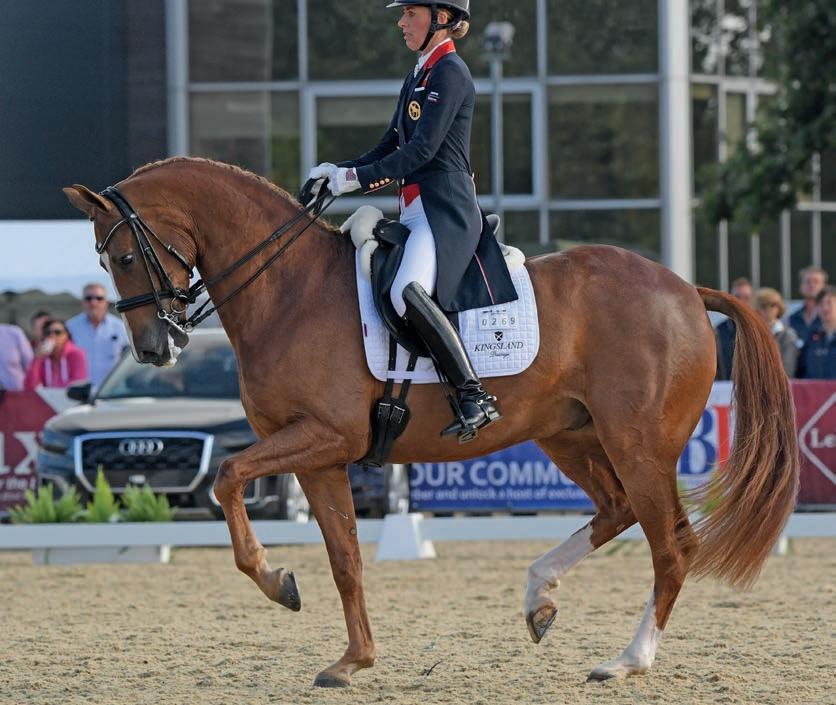

CASE STUDY – EMILY HARRIS
“High level dressage is hard work for horses, so I try to stay away from surfaces that are uneven or inconsistent, or which may cause strain or stress to the joints. It’s unfair to expect horses to train and compete if they are struggling against a poor surface. The main thing is that it is even and stable – a bit of regular maintenance goes a long way.”
Emily maintains variety in training and schooling: “I wouldn’t work on extensions or collection every day and make sure to give our horses plenty of breaks so they don’t get over-tired or fatigued as that’s when they are more likely to injure themselves. I also stay mindful of each horse’s physical capability, adjusting their work according to their age, strength and fi tness.”
Emily explains that as horses get older, they need consistent management and maintenance from an experienced sports vet.
“A regular veterinary review is useful for identifying potential problems before they become an issue. I keep to a strict schedule with physiotherapy and shoeing so that any changes are picked up quickly before they develop.
“Finding a team that you really trust is vital as is a holistic approach – it’s not enough to focus on one aspect of the management, you have to look at the horse as a whole.”
ABOVE INSET: THE RIGHT AMOUNT OF IMPACT ABSORPTION, ENERGY RETURN AND COHESION ARE ALL IMPORTANT IN THE CHOICE OF SURFACE. ABOVE: RESEARCH HAS SHOWN THAT A DRESSAGE HORSE PUTS MORE FORCE PER SQUARE INCH ON A SURFACE THAN IN OTHER DISCIPLINE. ABOVE: VARIETY IN TRAINING AND SCHOOLING HELPS TO AVOID INJURY, SUGGESTS EMILY HARRIS.


WHERE A HORSE HAS SHOWN A CHANGE IN GAIT OR RELUCTANCE TO MOVE FORWARDS, IT MAY BENEFICIAL TO FEED A SUPPLEMENT TO HELP BOOST NATURAL JOINT REPAIRING SUBSTANCES

“It’s important to have the right amount of impact absorption in a surface as well as energy return and cohesion. Generally, surfaces now are softer and more forgiving than they used to be, but with that comes increased maintenance. As a com any with years o scientifi c research and expertise behind them, the welfare of horses is paramount. We design our surfaces to not only provide the best conditions to prolong a horse’s ridden career, but also rovide confi dence or them to express themselves through movement.”
Andy Bathe concludes: “Avoiding injury starts by picking a sound horse with good conformation which is able to do the job and progresses with good training and attention to detail, something which dressage riders are very good at!”
A QUESTION OF INSURANCE Harriet Walker, Director and Claims Team Manager at KBIS:
Q: Are joint injuries covered by insurance?
A: “Any type of joint issue, whether it’s arthritis, OCD, an infected joint or an injury including sprains/ligament damage would be covered if you have full vet fee cover for accident, sickness and disease and the condition did not pre-exist your policy start date or an injury which could pre dispose the horse to such a condition, pre-existed the policy start date.”
Q: How is cover affected by ‘maintenance’ injections, or regular supplementation?
A: “We’re aware that it’s common to use joint supplements and/or other forms of preventive treatment and therapies in an effort to help maintain horses’ health. The disclosure of such treatment is dependent of what has been given and why it has been administered. Putting your horse on a non-prescriptive joint supplement because you think they could benefi t is unlikely to affect your policy. As long as the horse has shown no signs of stiffness, lameness, poor performance and/or been examined by a vet, you shouldn’t need to notify your insurer. ‘Maintenance’ injections have to be carried out by a vet so should be disclosed to your insurer. When this has been declared, if your horse is deemed to be a higher insurance risk as a result, we will always tell you what is excluded so you are aware.If they are being administered as preventative (no lameness present), there has been no injury or diagnosis as to a joint disease, then you wouldn’t be able to claim as insurance does not cover preventative treatment.
If the horse’s condition was to worsen and lameness and/or a diagnosis was present, your claim is likely to be affected by the fact the horse had previously had their joint(s) medicated, indicative that there was a preexisting underlying problem.
Infi ltrating the joint does itself pose an increased risk, which is also why a claim would not be covered in the future. In any case where information is not fully disclosed your claim could be invalid and/or the start date of your claim backdated to when symptoms fi rst arose or any veterinary procedure was carried out.”

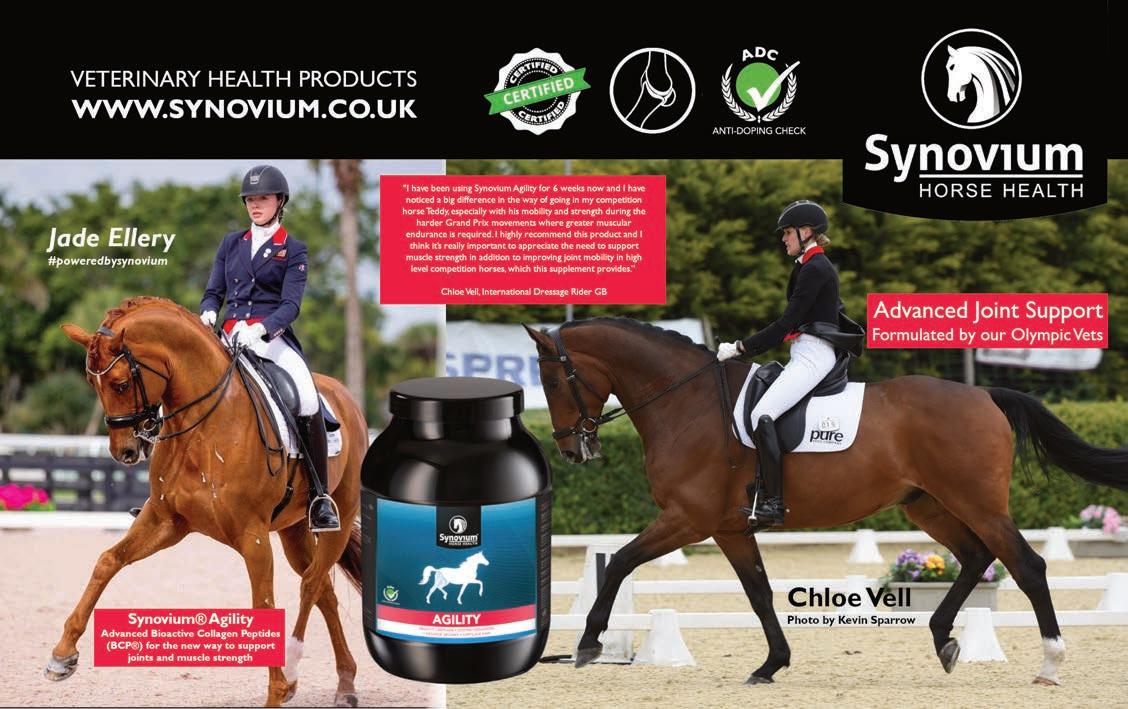


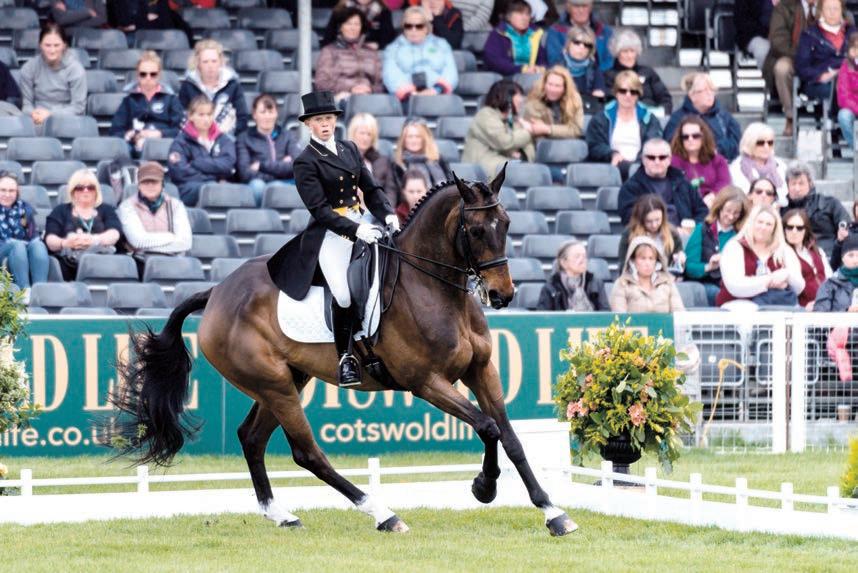
Ros Canter, World Champion.
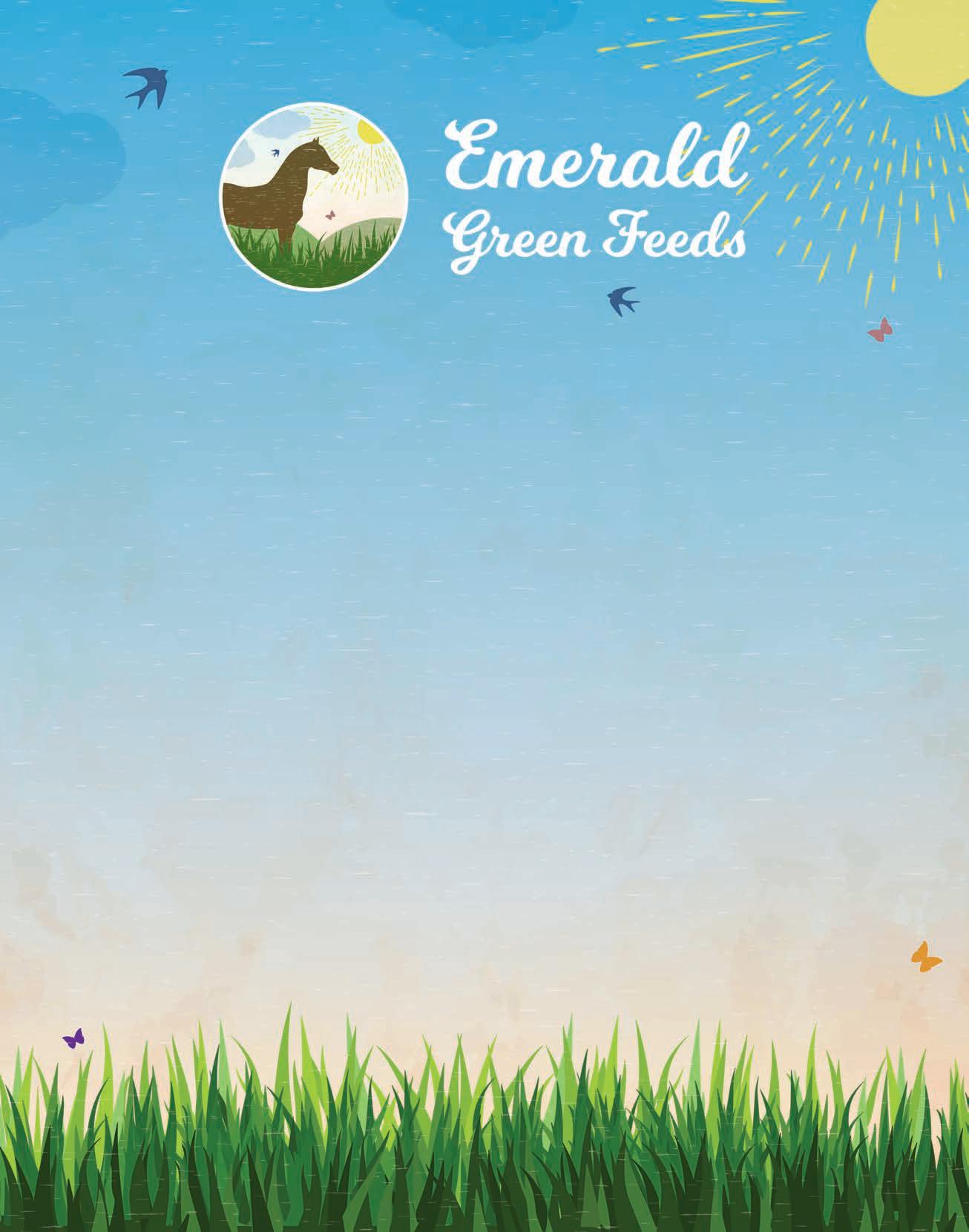
High Quality Low in Starch & High in Fibre From Vitamin A to Zinc Fully Traceable Slow Release Energy
JOINT CARE & MANAGEMENT
PRODUCT WATCH
SYNOVIUM® AGILITY BIOACTIVE COLLAGEN supports joint immobility, healthy cartilage and muscle structure. Synovium’s Agility is joint immobility, healthy cartilage and muscle structure. Synovium’s Agility is an innovative supplement developed by our team of Olympic vets to support horses from the leisure horse right through to the top competition horse. Bioactive Collagen Peptides (BCP®) are rapidly absorbed for the best results. Suitable for fussy eaters, easily added to feed or water and competition safe.
RRP: £68 FOR 1KG (1 MONTH SUPPLY) | synovium.co.uk
CORTAFLEX® HA SUPER FENN was created by leading equine nutritionists to provide powerful joint support for performance and competition horses, through a unique combination of collagen, amino acids, hyaluronic acid and trace elements, delivering the important nutritional building blocks to support joint health.
Cortafl ex® HA Super Fenn also contains Boswellia and MSM for additional joint and muscle comfort.
FOR 500G
equine-america.co.uk FLEXABILITY PROFESSIONAL is a high specifi cation joint and cartilage supplement for high performance horses and those needing higher level of support. It is one of the highest specifi cation joint supplements available in the UK and provides a unique combination and optimum levels of scientifi cally proven ingredients including Glucosamine, Chondroitin Sulphate, MSM, DHA and EPA (OMEGA 3), plus many more.
RRP: FROM £62.99
RRP: FROM £79.99
sciencesupplements.co.uk
BEST-FLEX HA® Optimise your horse’s joint health and comfort with Best-Flex HA®, probably the world’s best joint supplement. This proven supplement has received fantastic reviews from equestrians across the world, it provides the highest levels of all the important nutrients to aid fl exibility and suppleness whilst effectively supporting joints and connective tissues.

RRP: £71.99 | feedmark.com
VITAFLOOR offers a whole-body vibration therapy solution specifi cally designed for horses. Just ten minutes per day can help offer signifi cant increases in muscle power and fl exibility all while reducing the impact of increased workloads on joints. The positive effects of using vibration therapy as part of your warm-up can be signifi cant, with less energy being required for each transition into trot.
RRP: SEE WEBSITE | equinehealthcentre.com PRO-EQUINE'S ACTIVGAIT is specifi cally formulated to support equine joint mobility, cartilage health and elasticity. Activgait's 100% natural ingredients include powerful yucca, as well as celery seed and Chinese ginger, to work on the circulation and aid the speedy delivery of the ingredients to muscle and joints. Fastacting and competition legal, Activgait can be given regularly or just when needed, such as when competing or after heavy exertion. A small amount can make a big difference in just a couple of days.
RRP: FROM £17.95 | pro-equine.com
PRO JOINT PERFORMANCE is a concentrated powder-based supplement designed to maintain healthy joint function in horses. Using fi ve key ingredients, Pro Joint Performance is blended at the perfect ratio to help reduce infl ammation after intense riding sessions, increase overall joint lubrication and maintain
RRP: £40.00 FOR 500G POUCH
equinenutrition.vet/joint


optimum cartilage/ligament health.
FIVE STAR SUPERFLEX SENIOR is a unique formulation providing our highest specification of the key joint support nutrients for horses, working in synergy with rich natural sources of Omega 3 fatty acids and naturally sourced antioxidants to support healthy, flexible joints in older horses and ponies still leading active lives.

RRP: FROM £30.99 FOR 660G
Naf-equine.eu/uk
CAVALOR ARTITEC is the result of seven years' scientific research (ism UGent) into nutritional support for tendon and joint health in top sport horses. The result is a specific ingredient combination and ratio to not only help support healthy tendons and joints, but also provide protection from damage associated with overload. ArtiTec is formulated in such a way that the herbs have a synergetic effect and thus eliminate negative processes in the musculoskeletal system. During a pilot study1 Cavalor® ArtiTec was successfully absorbed in 97% of horses and 74% of those showed visible signs of improvement.
RRP: £164.20 | cavalordirect.co.uk
BETTALIFE PHARMAQUIN JOINT COMPLETE HA EQUINE is an extremely high specification joint supplement with a 10-10-4 Ratio of Glucosamine HCl, MSM and Chondroitin. PharmaQuin Joint CompleteHA Equine only contains the highest grade active ingredients and has zero additives.
RRP: £67.50 FOR 1KG | BETTAlife.co.uk
NUPAFEED FLEX GLM aims to sooth and nourish joints with the extraordinary power of Green Lipped Mussel. We use only the highest quality, stabilised mussel extract; nature’s most potent source of omega-3! Combined with anti-oxidants to support tissue recovery, Flex GLM is an uncompromising supplement to keep hard-working joints moving freely. All Nupafeed supplements are made to pharmaceutical standards and are suitable for FEI competition.

RRP: £49 FOR 2KG; £85 FOR 4KG; £165 FOR 8KG
nupafeed.co.uk ARTHRIAID POWDER supplies the necessary building blocks to aid your horse’s own natural manufacture of cartilage. ArthriAid lubricates and promotes regeneration of the important shock absorbing tissues of your horse’s joints. Available in high-strength liquid and powder with a tasty apple flavour, ArthriAid can be easily incorporated into your horse's feeding regime.
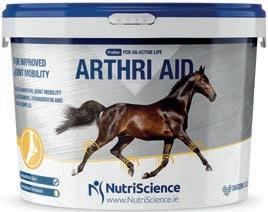
RRP: £44.50 FOR 1.2KG; £92.50 FOR 3KG
horsehealth.co.uk
EQUITOP GLME is a unique joint supplement specifically designed to support healthy joint function in horses. From the moment horses reach skeletal maturity, the normal ageing process kicks in and ongoing joint wear and tear is a key consideration for all owners. This is particularly important for horses in moderate to hard work, as every time they are exercised they will be encountering stresses and strains.
Containing sustainably harvested Green Lipped Mussel Extract (GLME) from New Zealand, Equitop® GLME offers ingredients that support your horse's joint health and soundness.

RRP: FROM £63.95 FOR 750G
equitop-myoplast.co.uk




